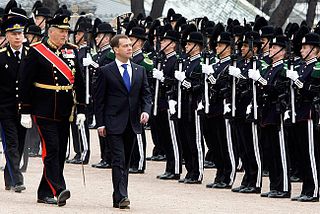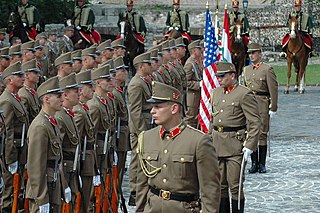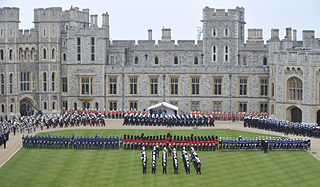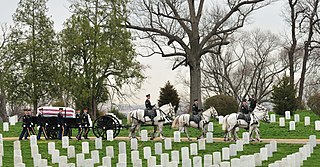
A militia is generally an army or some other fighting organization of non-professional and/or part-time soldiers; citizens of a country, or subjects of a state, who may perform military service during a time of need, as opposed to a professional force of regular, full-time military personnel; or, historically, to members of a warrior-nobility class. When acting independently militias are generally unable to hold ground against regular forces; militias commonly support regular troops by skirmishing, holding fortifications, or conducting irregular warfare, instead of undertaking offensive campaigns by themselves. Local civilian laws often limit militias to serve only in their home region, and to serve only for a limited time; this further reduces their use in long military campaigns. Militias may also, however, serve as a pool of available manpower for regular forces to draw from, particularly in emergencies.
Military science is the study of military processes, institutions, and behavior, along with the study of warfare, and the theory and application of organized coercive force. It is mainly focused on theory, method, and practice of producing military capability in a manner consistent with national defense policy. Military science serves to identify the strategic, political, economic, psychological, social, operational, technological, and tactical elements necessary to sustain relative advantage of military force; and to increase the likelihood and favorable outcomes of victory in peace or during a war. Military scientists include theorists, researchers, experimental scientists, applied scientists, designers, engineers, test technicians, and other military personnel.

Military police (MP) are law enforcement agencies connected with, or part of, the military of a state. In wartime operations, the military police may support the main fighting force with force protection, convoy security, screening, rear military reconnaissance, logistic traffic management, counterinsurgency, and detainee handling.

In some militaries, foot guards are senior infantry regiments. Foot guards are commonly responsible for guarding royal families or other state leaders, and they also often perform ceremonial duties accordingly, but at the same time are combat soldiers.

A military discharge is given when a member of the armed forces is released from their obligation to serve. Each country's military has different types of discharge. They are generally based on whether the persons completed their training and then fully and satisfactorily completed their term of service. Other types of discharge are based on factors such as the quality of their service, whether their service had to be ended prematurely due to humanitarian or medical reasons, whether they had been found to have drug or alcohol dependency issues and whether they were complying with treatment and counseling, and whether they had demerits or punishments for infractions or were convicted of any crimes. These factors affect whether they will be asked or allowed to re-enlist and whether they qualify for benefits after their discharge.

The Individual Ready Reserve (IRR) is a category of the Ready Reserve of the Reserve Component of the Armed Forces of the United States composed of former active duty or reserve military personnel. Its governing statute is codified at 10 U.S.C. § 10144. For soldiers in the National Guard of the United States, its counterpart is the Inactive National Guard (ING). As of 22 June 2004, the IRR had approximately 112,000 members composed of enlisted personnel and officers, with more than 200 Military Occupational Specialties are represented, including combat arms, combat support, and combat service support.

A drill team can be one of four different entities:
- A military drill team is a marching unit that performs routines based on military foot or exhibition drills. Military drill teams perform either armed or unarmed.
- A dance drill team creates routines based on precision dance movements rather than military drill. These teams usually do not carry anything, but may use props in field production numbers. They may perform to recorded music, or the live music of an accompanying marching band.
- A team that execute routines carrying either one or multiple flags or pom-poms. This team's movements are also based in dance and may also have a heavy influence of gymnastics as well. These teams also may perform to music, either live or recorded.
- A team that is mounted or advances some type of mobile object. May also include teams of dogs and handlers.

A Reserve Good Conduct Medal refers to any one of the five military conduct awards, four of which are currently issued and one of which was previously issued, by the United States Armed Forces to members of the Reserve and National Guard. The primary difference between the regular Good Conduct Medal and the Reserve Good Conduct Medal is that the regular Good Conduct Medal is only issued for active duty service while the reserve equivalent is bestowed for reserve duties such as drills, annual training, and additional active duty for either training or operational support to the active duty force or, in the case of the Army National Guard and Air National Guard, in support of Title 32 U.S.C. state active duty (SAD) such as disaster response and relief.

A reservist is a person who is a member of a military reserve force. They are otherwise civilians, and in peacetime have careers outside the military. Reservists usually go for training on an annual basis to refresh their skills. This person is usually a former active-duty member of the armed forces, and they remain a reservist either voluntarily, or by obligation. In some countries such as Israel, Norway, Finland, Singapore, and Switzerland, reservists are conscripted soldiers who are called up for training and service when necessary.

The Virginia Defense Force (VDF) is the official state defense force of Virginia, one of the three components of Virginia's state military along with the Virginia National Guard which includes the Virginia Army National Guard, the Virginia Air National Guard, and the unorganized militia. As of 2019, the VDF has approximately 250 soldiers. The VDF is the descendant of the Virginia State Guard, the Virginia Regiment, and ultimately the Colonial Virginia militia of the Virginia Colony.

A guard of honour (GB), also honor guard (US), also ceremonial guard, is a group of people, usually military in nature, appointed to receive or guard a head of state or other dignitaries, the fallen in war, or to attend at state ceremonials, especially funerals. In military weddings, especially those of commissioned officers, a guard, composed usually of service members of the same branch, form the Saber arch. In principle any military unit could act as a guard of honour. However, in some countries certain units are specially designated to serve as a guard of honour, as well as other public duties.

A military reserve force is a military organization whose members have military and civilian occupations. They are not normally kept under arms, and their main role is to be available when their military requires additional manpower. Reserve forces are generally considered part of a permanent standing body of armed forces, and allow a nation to reduce its peacetime military expenditures and maintain a force prepared for war.

The Black Brigade of Cincinnati was a military unit of African-American soldiers, that was organized in 1862 during the American Civil War, when the city of Cincinnati, Ohio, was in danger of being attacked, by the Confederate Army. The members of the Cincinnati "Black Brigade" were among the first African Americans to be employed in the military defense of the Union. The fortifications—including forts, miles of military roads, miles of rifle pits, magazines, and hundreds of acres of cleared forests—at the border of Northern Kentucky thwarted the major threat to Cincinnati during the Civil War.
The Canadian Militia is a historical title for military units raised for the defence of Canada. The term has been used to describe sedentary militia units raised from local communities in Canada; as well as the regular army for the Province of Canada and post-confederated Canada, referred to as the active militias.

In the United Kingdom, military conscription has existed for two periods in modern times. The first was from 1916 to 1920, and the second from 1939 to 1960. The last conscripted soldiers left the service in 1963. It was legally designated as "Military Service" from 1916 to 1920, and as "National Service" from 1939 to 1960. However, between 1939 and 1948, it was often referred to as "War Service" in documents relating to National Insurance and pension provision.

The military ranks of Ukraine were created in March 1992 after Ukraine adopted the law "About Universal Military Duty and Military Service". The rank structure of the Ukrainian Armed Forces originally corresponded to the generic military rank structure of the Soviet Union. Since then the rank system has been overhauled and, as of 2022, follows a NATO standardization.
The reserve components of the United States Armed Forces are military organizations whose members generally perform a minimum of 39 days of military duty per year and who augment the active duty military when necessary. The reserve components are also referred to collectively as the National Guard and Reserve.

The Diamond Jubilee Armed Forces Parade and Muster was a military parade held at Windsor Castle and Home Park in Windsor, Berkshire, England, organised as part of the Queen Elizabeth II's Diamond Jubilee celebrations. Performed as a tribute to the Queen on behalf of all three branches of the British Armed Forces, it featured a review of members of all three services by the monarch, a military parade through the town, and flypasts by current and historic military aircraft.

A military funeral in the United States is a memorial or burial rite conducted by the United States Armed Forces for a Soldier, Marine, Sailor, Airman, Guardian or Coast Guardsman who died in battle, a veteran, or other prominent military figures or a president. A military funeral may feature guards of honor, the firing of volley shots as a salute, drumming and other military elements, with a flag draping over the coffin.
The Regular Reserve is the component of the military reserve of the British Armed Forces whose members have formerly served in the "Regular" forces. The Regular Reserve largely consists of ex-Regular personnel who retain a statutory liability for service and are liable to be recalled for active military duty "in case of imminent national danger or great emergency". It also consists of a smaller number of ex-Regulars who serve under a fixed-term reserve contract and are liable for reporting, training and deploying on operations.















